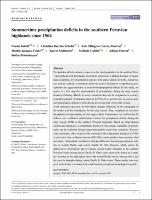Mostrar el registro sencillo del ítem
Summertime precipitation deficits in the southern Peruvian highlands since 1964
| dc.contributor.author | Imfeld, N. | |
| dc.contributor.author | Barreto Schuler, Christian | |
| dc.contributor.author | Correa, Kris | |
| dc.contributor.author | Jacques-Coper, M. | |
| dc.contributor.author | Sedlmeier, v | |
| dc.contributor.author | Gubler, S. | |
| dc.contributor.author | Huerta, Adrian | |
| dc.contributor.author | Brönnimann, v | |
| dc.date.accessioned | 2019-07-27T20:22:39Z | |
| dc.date.available | 2019-07-27T20:22:39Z | |
| dc.date.issued | 2019-03 | |
| dc.identifier.uri | http://repositorio.senamhi.gob.pe/handle/20.500.12542/89 | |
| dc.description.abstract | Precipitation deficits remain a concern to the rural population in the southern Peruvian highlands and knowledge about their occurrence is lacking because of scarce data availability. For mountainous regions with sparse station networks, reanalyses can provide valuable information; however, known limitations in reproducing precipitation are aggravated due to unresolved topographical effects. In this study, we assess in a first step the representation of precipitation during the rainy season (January–February–March) in seven reanalysis data sets in comparison to a newly generated gridded precipitation data set for Peru. In a second step, we assess summer precipitation deficits in Peru during the second half of the 20th century. In the reanalyses data sets, we find biases strongly influenced by the topography of the models and low correlations for the rainy season. Thus, reanalyses do not solve the problem of data scarcity for this region either. Furthermore, we confirm that El Niño is not a sufficient stratification criterion for precipitation deficits during the rainy season (JFM) in the southern Peruvian highlands. Based on observational records and reanalyses, a considerable fraction of inter-annual variability of precipitation can be explained through upper-tropospheric zonal wind anomalies. Westerly wind anomalies, often related to the warming of the troposphere during an El Niño event, lead to dry conditions, but not all El Niño events produce these westerly wind anomalies. Atmospheric simulations indicate differences between precipitation deficits in central Pacific and eastern Pacific El Niño flavours, which cannot be addressed in observations due to reduced record length: Droughts in the southern Peruvian Andes during eastern Pacific El Niño events seem to be related to a stronger warming in the troposphere above the central Pacific ocean, whereas this is not the case for droughts during central Pacific El Niño events. These results, however, need to be further corroborated by model studies and palaeoclimatological research. | en_US |
| dc.format | application/pdf | |
| dc.language.iso | eng | en_US |
| dc.publisher | John Wiley and Sons Ltd | en_US |
| dc.relation.ispartof | urn:issn:0899-8418 | |
| dc.rights | info:eu-repo/semantics/openAccess | es_PE |
| dc.rights | Attribution-NonCommercial-ShareAlike 3.0 United States | * |
| dc.rights.uri | http://creativecommons.org/licenses/by-nc-sa/3.0/us/ | * |
| dc.source | Servicio Nacional de Meteorología e Hidrología del Perú | es_PE |
| dc.source | Repositorio Institucional - SENAMHI | es_PE |
| dc.subject | Drought | en_US |
| dc.subject | ENSO | en_US |
| dc.subject | ERA-20CM | en_US |
| dc.subject | Mountain | en_US |
| dc.subject | Peru | en_US |
| dc.subject | Rainfall | en_US |
| dc.subject | Reanalysis | en_US |
| dc.subject | SPI | en_US |
| dc.title | Summertime precipitation deficits in the southern Peruvian highlands since 1964 | en_US |
| dc.type | info:eu-repo/semantics/article | en_US |
| dc.identifier.isni | 0000 0001 0746 0446 | |
| dc.description.peerreview | Por pares | |
| dc.identifier.doi | https://doi.org/10.1002/joc.6087 | |
| dc.source.journal | International Journal of Climatology | es_PE |
Ficheros en el ítem
Este ítem aparece en la(s) siguiente(s) colección(es)
-
Artículo científico [168]









